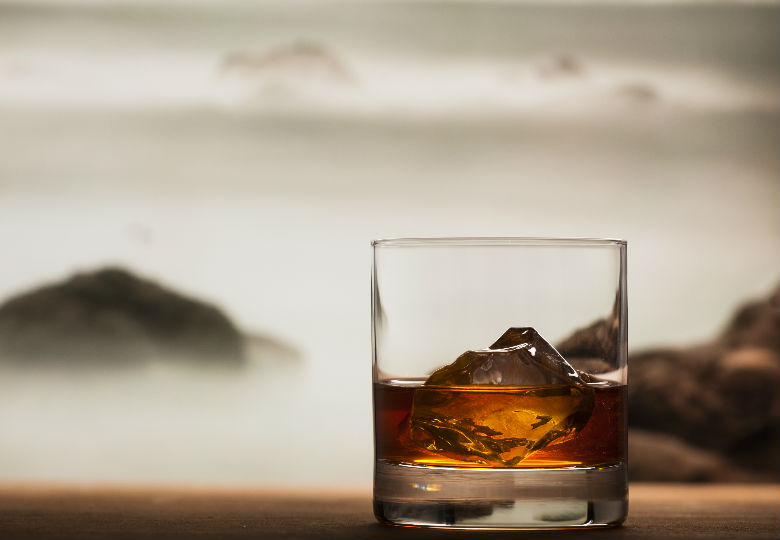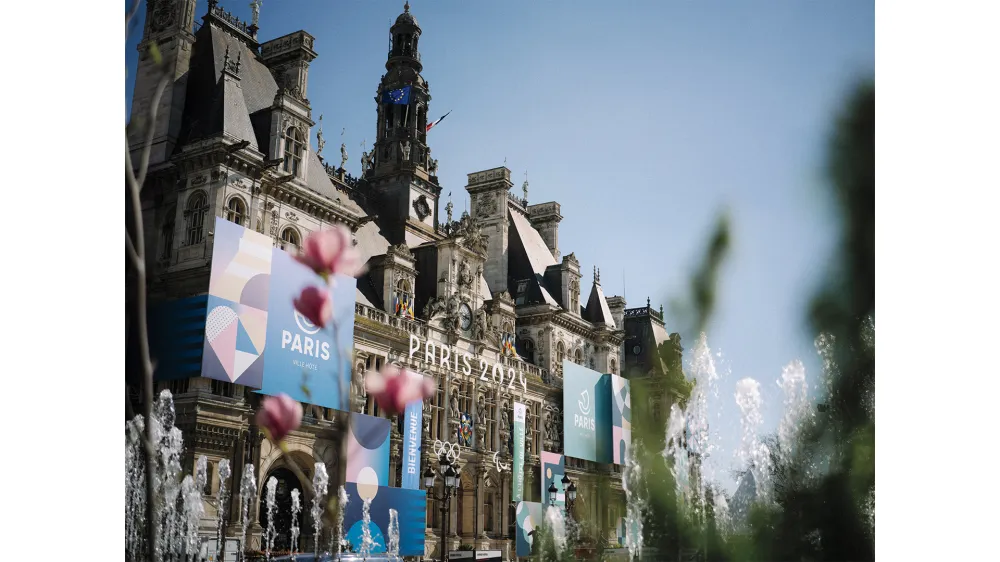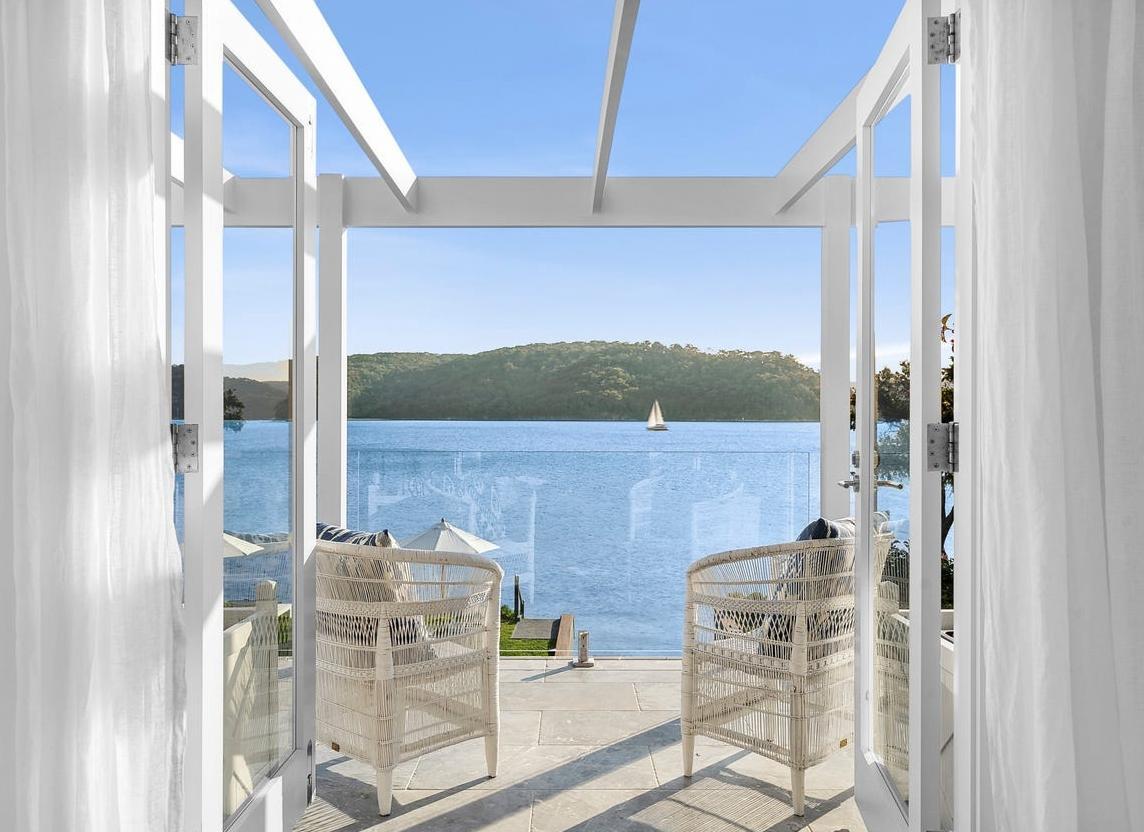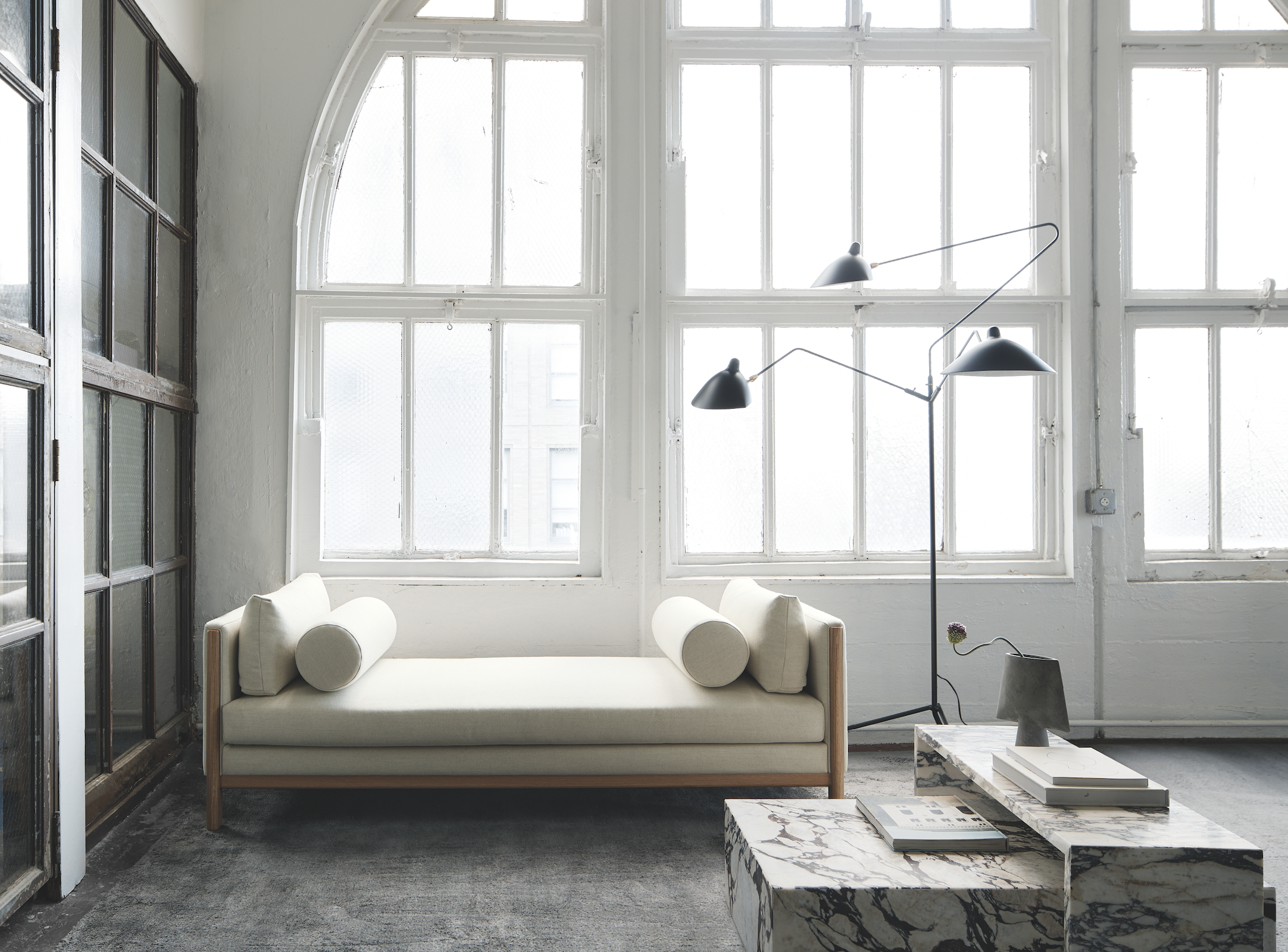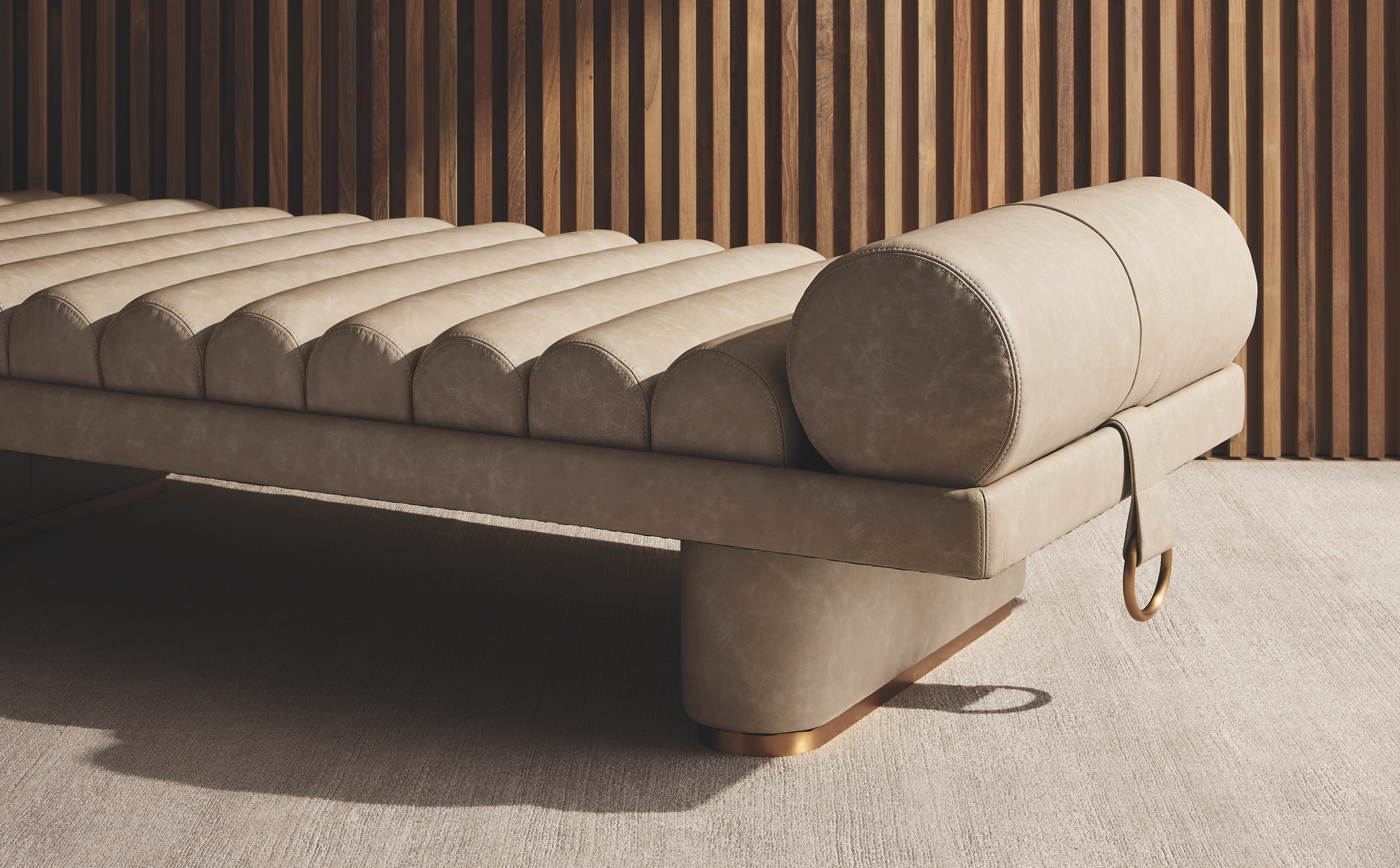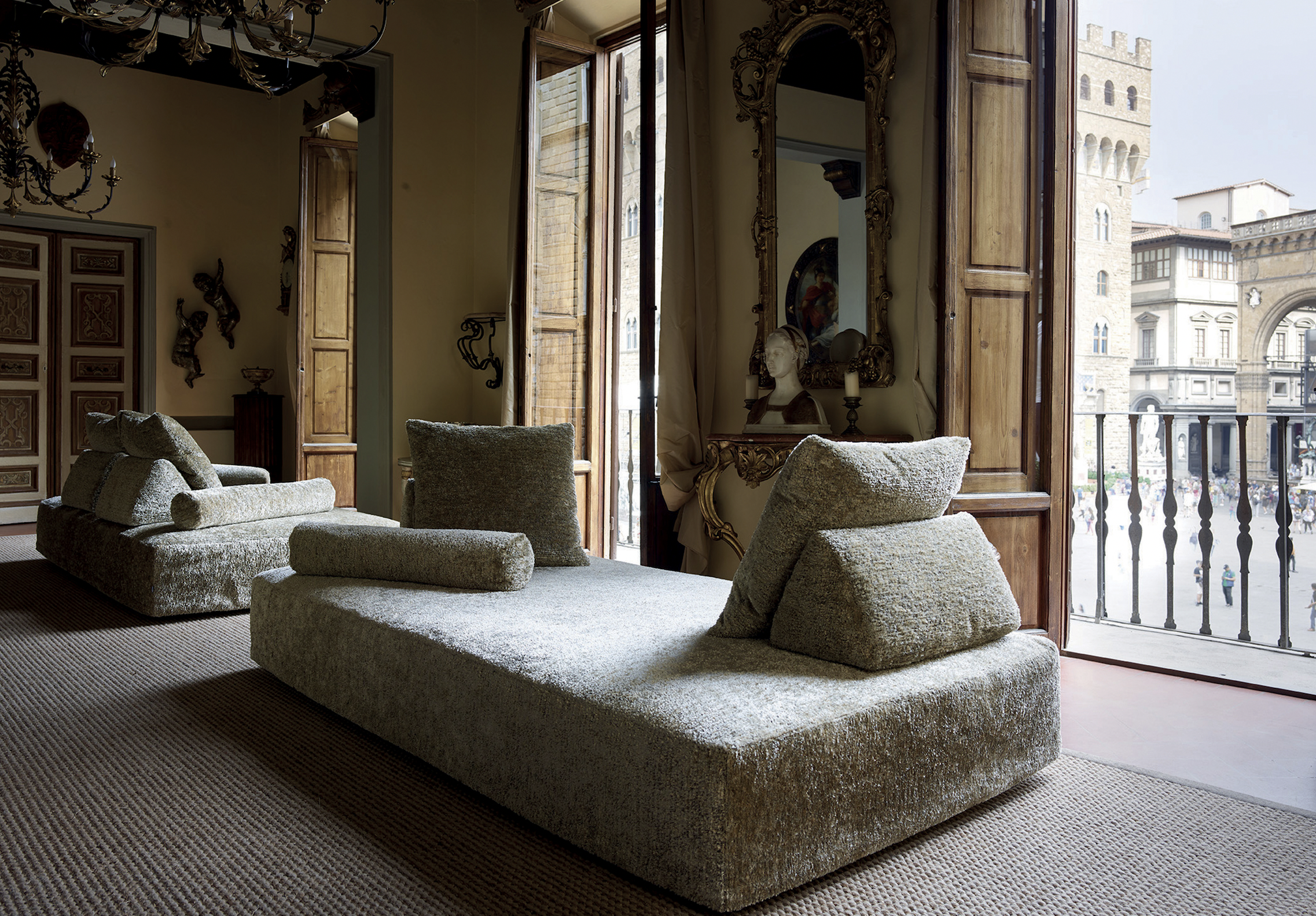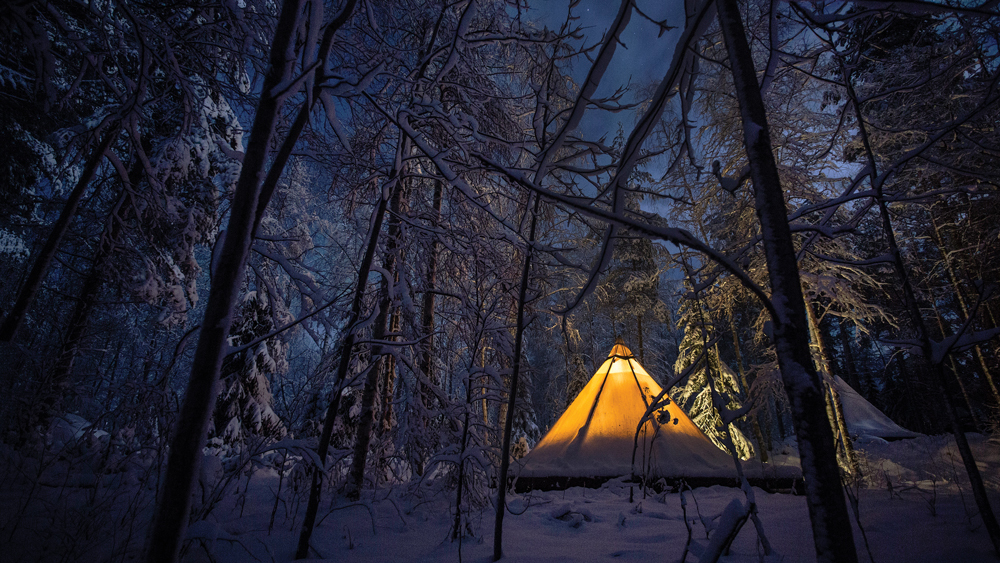
Why your next Safari should happen in Sweden (Yes, Sweden)
The remote forests of Sweden’s unsullied Lapland are home to their fair share of year-round adventures. Here’s a peek into some of the best.
Related articles
It’s 10pm by the time we set out in the speedboat, and the sun is still reflecting off the glass-like surface of the Råne River. Jonas Gejke is at the boat’s helm, navigating cautiously through the shallows en route to deeper water. The grizzled safari guide eventually cuts the engine and, surveying the river floor, gives the nod for his first passenger to jump in.
Gejke tosses his passenger a rope that’s dangling from the boat’s stern. Turning back, he grins and hits hard on the engine, its guttural roar leaving a struggling skier in its wake—and prompting a chorus of shrieks, whistles, and laughter from everyone on board.
Such is how you safari in Sweden.
Our group is based at the Aurora Safari Camp, a four-tent-and-one-toilet outpost on the shores of the Råne in Swedish Lapland. Gejke and his business partner, the professional photographer Fredrik Broman, run the camp as part of their Aurora Safaris Sweden, which offers year-round adventures in the wilderness north of Luleå. In summer months their guests hike, fish, kayak, and otherwise enjoy the 20-some hours of daily sunlight. In winter-high season in Swedish Lapland-they brave the bitter cold on snowmobiles, skis, and dogsleds, and spend the long nights angling for views of the aurora borealis.

Dogsledding in Sweden
Frederik Broman/Aurora Safari Camp
In this land of extremes, Gejke is a moderating force. Barrel-chested and grey-bearded, he looks every bit the safari guide: problem solver, survivor, people protector-the kind of person you want around when you’re in the middle of nowhere. His professional pedigree supports such confidence, anchored by his more than two decades running a safari business in Kenya. But it’s here, in his homeland’s far north, where he sees a true frontier.
“It’s gotten to a point where it’s about to explode,” says Gejke, who moved back to Sweden with his Kenyan wife and three children last year to join forces with Broman. “The solitude in the wilderness up here is something that’s completely unique. Fredrik and I, we see opportunities behind every corner. It’s like the Wild West, in a way.”
Gejke and Broman aren’t the only ones who see an up-and-coming safari destination in Sweden. From the northern wilds to the Stockholm Archipelago, modern-day prospectors are mimicking the classic African adventures in an only-in-Sweden style. Unlike in much of sub-Saharan Africa, where the animals are the main attraction on safari, in Sweden it’s the offbeat experiences, seasonal severity, and opportunities for pure, unadulterated fun that draw curious travellers.
Skewing more summer camp than extreme sport, our evening adventure with Aurora Safaris started on the camp’s floating sauna, where Gejke was busy doing everything from baiting our fishing lines to setting out a spread of moose- jerky and reindeer-sausage appetisers. Once we’re on the boat, our outbursts fill the empty river valley, echoing off the dense stands of pines that rise from either shore. Gradually, however, the sun dips below the horizon, our skiing session winds down, and we return to camp in the all-consuming silence of Swedish Lapland.
For all of their adventures in this isolated Arctic region, Aurora’s partners borrow heavily from Gejke’s African playbook. Their remote camp, with its canvas-top accommodations situated around a main dining tent, emulates many of the amenities and activities of its African exemplars—but always with a Swedish slant. Rather than a sundowner on the savanna, for instance, Aurora might stage a Champagne “moonriser” on a bar carved from the ice on a frozen lake. In place of a mokoro trip down a crocodile-infested river, Gejke might take you river rafting on the Råne. Instead of an excursion by elephant back, you might sled across the Arctic Circle behind a team of dogs while wearing a moon suit to keep out the winter cold.

Aurora Safari Camp
Frederik Broman/Aurora Safari Camp
Of course, imitating an African-safari experience in Sweden is not always simple—or possible. The multitasking Gejke is indicative of the challenges outfitters face in a Scandinavian country with high labour costs. “In Africa, running a camp with 10 beds you generally have 25 to 40 people doing it behind you,” he says. “Here, you run a camp with 12 beds, and we have two of us.”
The inherent hurdles go beyond just numbers. In a country where most natives are happy taking a tent into the woods, the concept of luxury is relative—and service is far from second nature. Travelers throughout Sweden are often left to haul their own luggage; coffee may or may not be ready when you wake up in the morning; and, except in city hotels, private bathrooms aren’t a priority.
“Most people in Sweden have no concept of what luxury is and what the luxury customer expects,” says Marina Safonova, owner of the Scandinavian tour company Nordic Luxury. “The farther north you go, you can have untouched wilderness all to yourself, but there are no luxury hotels.”
Sweden’s lack of five-star options is not limited to the north—even Stockholm is devoid of marquee international-brand hotels. But the country’s nonconformity is also one of its charms. An adventure through Sweden feels truly Swedish. Rather than standardise your experience, the locals just do what they do normally and hope you like it (even if they sometimes seem like they don’t care if you do).
“I share my lifestyle with people who come here, and I get to live in the middle of all this,” says Gejke. “And that’s really what the destination is about. There’s nothing fake about it.”
Torkild Berglund and Kristina Bonde live in the middle of the Stockholm Archipelago, about an hour’s speedboat ride from the Swedish capital. Across a narrow channel from their home, the husband-and-wife team offer their own take on a Swedish safari lodge—and share their own version of the local lifestyle.

Opened in 2012, their eight-tent Island Lodge occupies one of the nearly 30,000 isles in the sprawling archipelago. In the same spirit as Aurora, the lodge was modelled after safari camps in Southern Africa, where Bonde spent much of her childhood.
“It’s a luxury outdoor experience, inspired by the safari concept developed by the Brits in the old days,” says Berglund of the camp, which is open from late spring to early fall. “Pure outdoor luxury— with a bit of hardship.”
That hardship includes shared bathrooms (one each for two sets of four tents) and a do-it-yourself service mentality. But the magic of the Island Lodge lies in its simplicity. The island is more or less yours. (It’s available as either a buyout or a split, with two groups taking the two sides of the camp privately.) Its geodesic-dome tents, which are outfitted with reindeer-skin rugs and wood-burning stoves, are set just off a boulder-strewn shore, where you can sunbathe, swim, or fish for perch from the rocks. And a floating sauna deck— apparently a prerequisite for Swedish safari lodges—offers grab-and-go kayaks and paddleboards, and a jumping-off point for adventures in the archipelago.
My adventures were mostly confined to the island itself, with Berglund bringing me the occasional beer while I swam, paddleboarded, and fished off the sauna deck. At one point he pulled up in his rigid inflatable boat, offering to take me to the other side of the island. A few minutes into our tour, he convinced me to swim to shore, scale a 30-foot cliff, and leap off.
Back at my tent, I could see and hear Swedish families on an opposite island enjoying their day much as I was enjoying mine—swimming, fishing, jumping off rocks. A speedboat whizzed through the channel, while a sailboat tucked into a nearby cove to drop anchor for the night.
“The wealthiest Swedish people have their own yacht and go out in the archipelago, where they can easily find a small island,” says Berglund. “Experiencing Island Lodge (requires) no skills and no knowledge about the archipelago. Finding an uninhabited island with primeval forest within a one-hour boat ride from the capital—that’s unique.”

The Swedish Lapland
Frederik Broman/Aurora Safari Camp
Coming upon an isolated stretch in Swedish Lapland is not so novel. Outside of Luleå, a city of some 75,000 residents, pine and birch trees blanket the terrain, broken only by the occasional country house or salmon-filled river. For outsiders, it’s a limitless land of all-enveloping wilderness, endless sunlight in summer, and incomprehensible cold in winter.
“Most people haven’t experienced a proper outdoor winter, and they’re stepping out of their comfort zones doing activities when it’s minus 20 Celsius,” Gejke says. “They think that they’ll never, ever swim in that ice hole in the lake, but they end up doing it anyway.”
“You go there to do things you haven’t done before and see things you haven’t seen before,” says Safonova. “The northern lights—it’s not even a guarantee that you’ll see them, maybe a fifty-fifty chance. But they just keep getting more popular.”
Aurora Safaris is not alone in trying to capitalize on the region’s rising popularity. Last winter, the upstart Arctic Retreat opened outside the village of Gunnarsbyn, about a half hour’s drive from the Aurora Safari Camp. Consisting of a relatively posh pair of cabins and a sauna directly on the Råne River, the exclusive-use property offers a highly civilised base for more vigorous adventures in the surrounding forest.
The Aurora team, too, is adding to the options in Swedish Lapland. Gejke says they plan to launch a mobile safari—involving hut-to-hut skiing, dogsledding, and snowmobiling—next winter. In the meantime, this January, they’re opening the Outpost Lodge, a six-room, all-season hotel set in a con- verted post office and general store in a village with a population of six.
“It’s at a T-junction,” Gejke says. “Once you pass the junction, there’s nothing. For 150 kilometres, it’s complete and utter wilderness out there. It’s the last stop.”
The sense of isolation Aurora Safaris offers can be more than some guests bargain for. Gejke, after all, can’t be in two places at once, as we soon discover back at camp.
After helping us get settled into our tepee-style tents, each with three simple beds surrounding a wood-burning heater, our guide bids us farewell. He promises to return early the next morning to make coffee and breakfast (and says that if this were winter, he would definitely not be leaving us to fend for ourselves). For now, however, he’s jumping in his boat and heading home to his family.
As Gejke disappears around a bend, and the putter of his engine fades away, our seclusion sets in. We are alone in the silence and, if only for a few hours, the darkness of Swedish Lapland.

The Swedish Big Five
Africa has the lion, leopard, rhino, elephant, and buffalo. In Sweden, however, the concept of safari-a term derived from the Arabic and Swahili words for “journey”— is more about the seasons and experiences than the species. Following are the five big-ticket attractions in Swedish Lapland, according to Jonas Gejke, a native Swede and 24-year Kenya resident who’s led countless safaris in both countries.
Aurora Borealis
“This is the place to see it. Swedish Lapland is so scantily populated, and the farther out in the wilderness you are-where you have no light pollution-the better it is. That’s the number one thing people come to see, but even when they don’t see it, they forget that they came for that because they had such an amazing experience anyway.”
Midnight Sun
“Pretty much the opposite of the aurora, but as an ultimate experience it’s very similar. To be able to sit here in the wilderness at 12 o’clock at night and the sun doesn’t set-that’s quite unique.”
Arctic Circle
“Crossing over the Arctic Circle on a snowmobile expedition, it’s like crossing the equator in Africa. There’s one crossing where you’re driving a snowmobile for endless kilometres, and then there’s this big arch made by an artist in the middle of nowhere.”
Moose
“The moose is such a nice animal. You see a lot of it during the summer months, but during winter it’s really the king of the forest,” when heavy snow tends to drive even these hearty mammals down from the mountains and closer to the coast; like humans, they find it easier to walk on roads than in deep snow. “I saw 34 in one day this winter.”
Wilderness
“There are very few places on Earth where you have proper wilderness. People have this dream about African wilderness, but if I break down in a car anywhere in Africa, within five minutes there’s someone there to help. You break down here in the winter-one of these side roads where you have no reception on your phone-you’ll freeze to death. Up here, if there’s no wind, there’s no noise—there’s nothing. You can hear yourself think.”
Subscribe to the Newsletter
Recommended for you
For Peat’s Sake: Scotland’s ‘Whisky Island’
There’s a reason Islay produces some of the world’s most characterful whisky. And it’s hidden in the undergrowth.
By Nick Ryan
July 22, 2024
How Paris’s Dining, Hotel and Art Scene Got Their Groove Back — Just in Time for the Olympics
The French capital’s cultural life was already on the upswing. Mix in a major global sporting event, and it’s now ready to go toe to toe with any city in the world.
By Vivian Song
July 9, 2024
You may also like.
By Josh Bozin
24/07/2024
You may also like.
5 Lounge Chairs That Add Chic Seating to Your Space
Daybeds, the most relaxed of seating solutions, offer a surprising amount of utility.
Chaise longue, daybed, recamier, duchesse brisée—elongated furniture designed for relaxing has a roster of fancy names. While the French royal court of Louis XIV brought such pieces to prominence in fashionable European homes, the general idea has been around far longer: The Egyptian pharaohs were big fans, while daybeds from China’s Ming dynasty spurred all those Hollywood Regency fretwork pieces that still populate Palm Beach living rooms. Even Mies van der Rohe, one of design’s modernist icons, got into the lounge game with his Barcelona couch, a study of line and form that holds up today.
But don’t get caught up in who invented them, or what to call them. Instead, consider their versatility: Backless models are ideal in front of large expanses of glass (imagine lazing on one with an ocean view) or at the foot of a bed, while more structured pieces can transform any corner into a cozy reading nook. Daybeds may be inextricably linked to relaxation, but from a design perspective, they put in serious work.
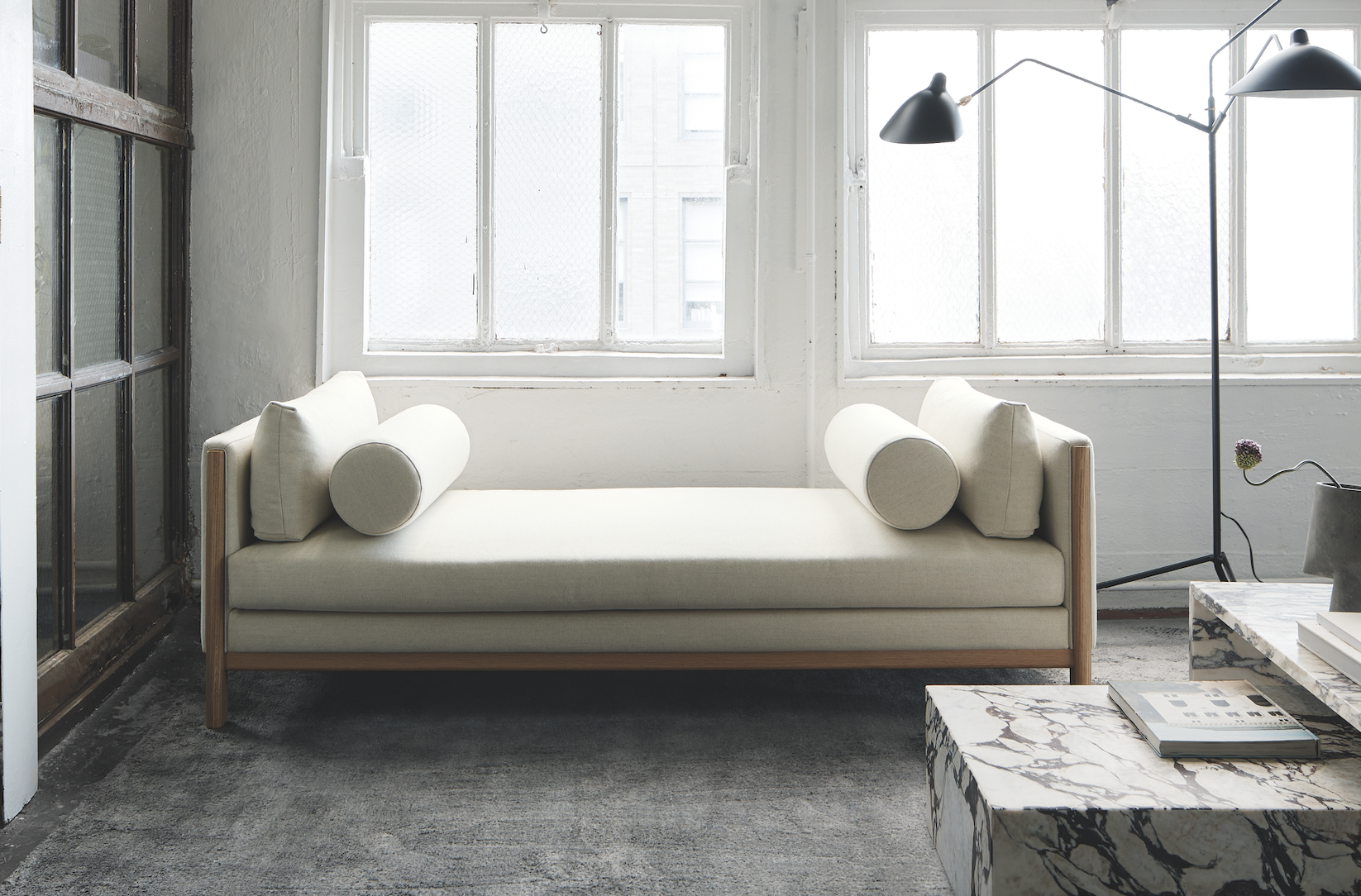
Emmy, Egg Collective
In designing the Emmy chaise, the Egg Collective trio of Stephanie Beamer, Crystal Ellis and Hillary Petrie, who met as students at Washington University in St. Louis, aimed for versatility. Indeed, the tailored chaise looks equally at home in a glass skyscraper as it does in a turn-of-the-century town house. Combining the elegance of a smooth, solid oak or walnut frame with the comfort of bolsters and cushioned upholstery or leather, it works just as well against a wall or at the heart of a room. From around $7,015; Eggcollective.com
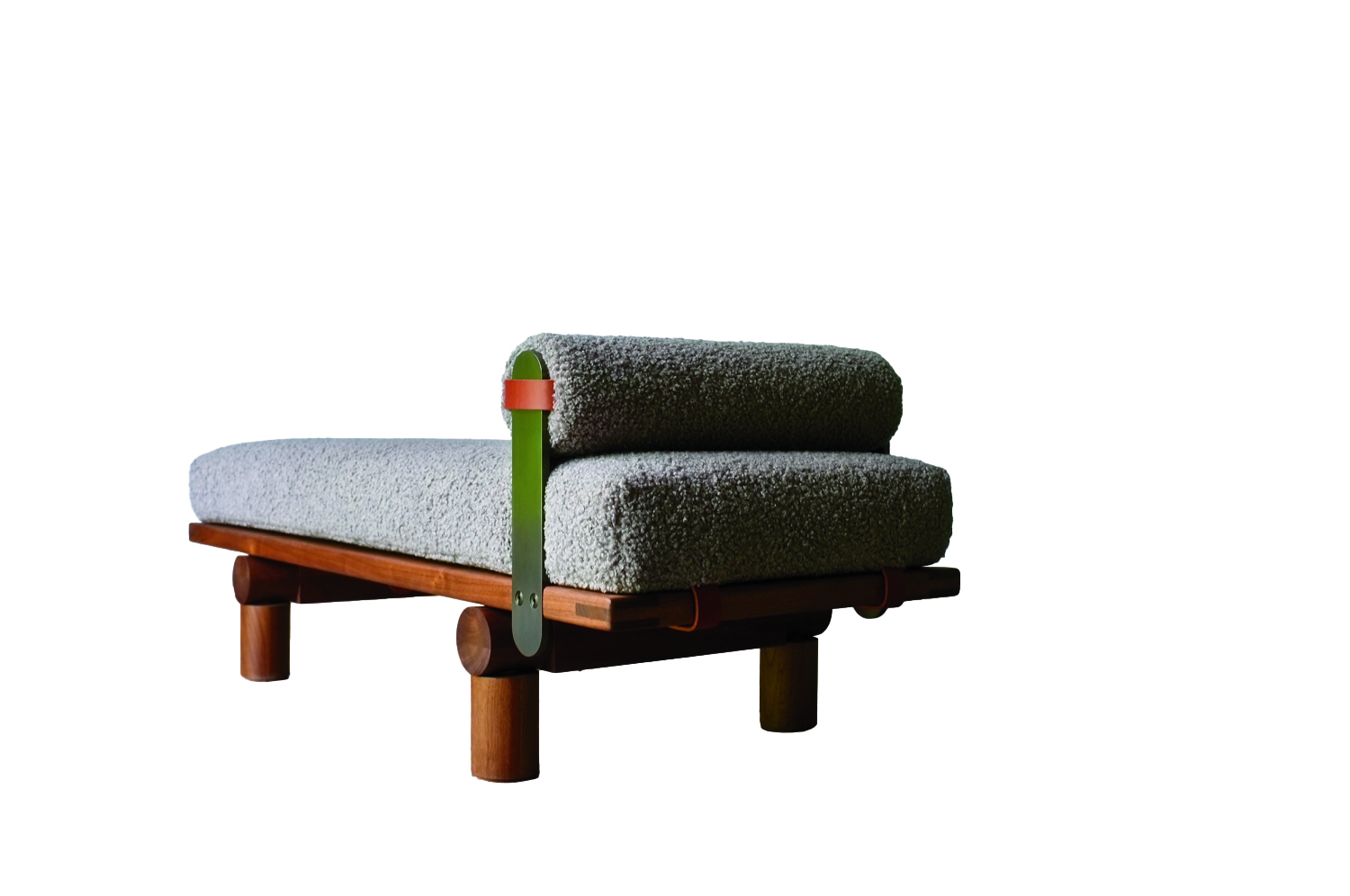 Plum, Michael Robbins
Plum, Michael Robbins
Woodworker Michael Robbins is the quintessential artisan from New York State’s Hudson Valley in that both his materials and methods pay homage to the area. In fact, he describes his style as “honest, playful, elegant and reflective of the aesthetic of the Hudson Valley surroundings”. Robbins crafts his furniture by hand but allows the wood he uses to help guide the look of a piece. (The studio offers eight standard finishes.) The Plum daybed, brought to life at Robbins’s workshop, exhibits his signature modern rusticity injected with a hint of whimsy thanks to the simplicity of its geometric forms. Around $4,275; MichaelRobbins.com
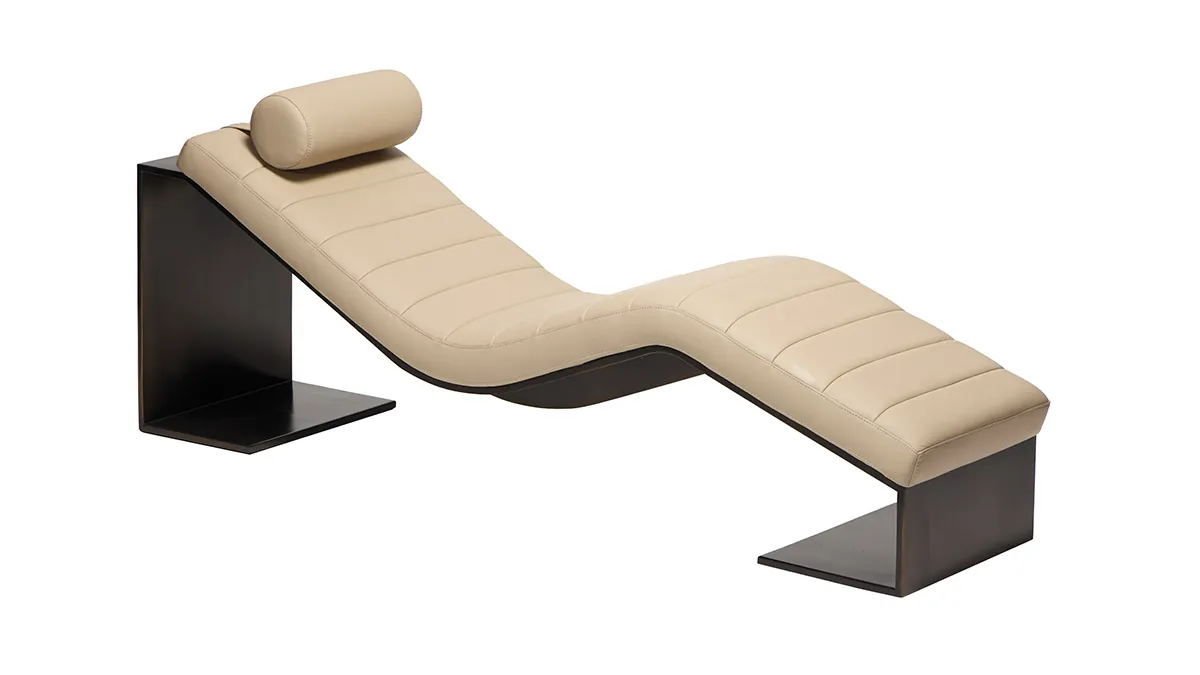
Kimani, Reda Amalou Design
French architect and designer Reda Amalou acknowledges the challenge of creating standout seating given the number of iconic 20th-century examples already in existence. Still, he persists—and prevails. The Kimani, a bent slash of a daybed in a limited edition of eight pieces, makes a forceful statement. Its leather cushion features a rolled headrest and rhythmic channel stitching reminiscent of that found on the seats of ’70s cars; visually, these elements anchor the slender silhouette atop a patinated bronze base with a sure-handed single line. The result: a seamless contour for the body. Around $33,530; RedaAmalou
Dune, Workshop/APD
From a firm known for crafting subtle but luxurious architecture and interiors, Workshop/APD’s debut furniture collection is on point. Among its offerings is the leather-wrapped Dune daybed. With classical and Art Deco influences, its cylindrical bolsters are a tactile celebration, and the peek of the curved satin-brass base makes for a sensual surprise. Associate principal Andrew Kline notes that the daybed adeptly bridges two seating areas in a roomy living space or can sit, bench-style, at the foot of a bed. From $13,040; Workshop/ APD
Sherazade, Edra
Designed by Francesco Binfaré, this sculptural, minimalist daybed—inspired by the rugs used by Eastern civilizations—allows for complete relaxation. Strength combined with comfort is the name of the game here. The Sherazade’s structure is made from light but sturdy honeycomb wood, while next-gen Gellyfoam and synthetic wadding aid repose. True to Edra’s amorphous design codes, it can switch configurations depending on the user’s mood or needs; for example, the accompanying extra pillows—one rectangular and one cylinder shaped— interchange to become armrests or backrests. From $32,900; Edra
You may also like.
By Josh Bozin
24/07/2024
22/07/2024
Watches & Wonders 2024 Showcase: Hermès
We head to Geneva for the Watches & Wonders exhibition; a week-long horological blockbuster featuring the hottest new drops, and no shortage of hype.
With Watches & Wonders 2024 well and truly behind us, we review some of the novelties Hermès presented at this year’s event.
—
HERMÈS

Moving away from the block colours and sporty aesthetic that has defined Hermès watches in recent years, the biggest news from the French luxury goods company at Watches & Wonders came with the unveiling of its newest collection, the Hermès Cut.
It flaunts a round bezel, but the case middle is nearer to a tonneau shape—a relatively simple design that, despite attracting flak from some watch aficionados, works. While marketed as a “women’s watch”, the Cut has universal appeal thanks to its elegant package and proportions. It moves away from the Maison’s penchant for a style-first product; it’s a watch that tells the time, not a fashion accessory with the ability to tell the time.
Hermès gets the proportions just right thanks to a satin-brushed and polished 36 mm case, PVD-treated Arabic numerals, and clean-cut edges that further accentuate its character. One of the key design elements is the positioning of the crown, boldly sitting at half-past one and embellished with a lacquered or engraved “H”, clearly stamping its originality. The watch is powered by a Hermès Manufacture movement H1912, revealed through its sapphire crystal caseback. In addition to its seamlessly integrated and easy-wearing metal bracelet, the Cut also comes with the option for a range of coloured rubber straps. Together with its clever interchangeable system, it’s a cinch to swap out its look.
It will be interesting to see how the Hermès Cut fares in coming months, particularly as it tries to establish its own identity separate from the more aggressive, but widely popular, Ho8 collection. Either way, the company is now a serious part of the dialogue around the concept of time.
—
Read more about this year’s Watches & Wonders exhibition at robbreport.com.au
You may also like.
22/07/2024
Living La Vida Lagerfeld
The world remembers him for fashion. But as a new tome reveals, the iconoclastic designer is defined as much by extravagant, often fantastical, homes as he is clothes.
“Lives, like novels, are made up of chapters”, the world-renowned bibliophile, Karl Lagerfeld, once observed.
Were a psychological-style novel ever to be written about Karl Lagerfeld’s life, it would no doubt give less narrative weight to the story of his reinvigoration of staid fashion houses like Chloe, Fendi and Chanel than to the underpinning leitmotif of the designer’s constant reinvention of himself.
In a lifetime spanning two centuries, Lagerfeld made and dropped an ever-changing parade of close friends, muses, collaborators and ambiguous lovers, as easily as he changed his clothes, his furniture… even his body. Each chapter of this book would be set against the backdrop of one of his series of apartments, houses and villas, whose often wildly divergent but always ultra-luxurious décor reflected the ever-evolving personas of this compulsively public but ultimately enigmatic man.
With the publication of Karl Lagerfeld: A Life in Houses these wildly disparate but always exquisite interiors are presented for the first time together as a chronological body of work. The book indeed serves as a kind of visual novel, documenting the domestic dreamscapes in which the iconic designer played out his many lives, while also making a strong case that Lagerfeld’s impact on contemporary interior design is just as important, if not more so, than his influence on fashion.

In fact, when the first Lagerfeld interior was featured in a 1968 spread for L’OEil magazine, the editorial describes him merely as a “stylist”. The photographs of the apartment in an 18th-century mansion on rue de Université, show walls lined with plum-coloured rice paper, or lacquered deepest chocolate brown in sharp contrast to crisp, white low ceilings that accentuated the horizontality that was fashionable among the extremely fashionable at the time. Yet amid this setting of aggressively au courant modernism, the anachronistic pops of Art Nouveau and Art Deco objects foreshadow the young Karl’s innate gift for creating strikingly original environments whose harmony is achieved through the deft interplay of contrasting styles and contexts.
Lagerfeld learned early on that presenting himself in a succession of gem-like domestic settings was good for crafting his image. But Lagerfeld’s houses not only provided him with publicity, they also gave him an excuse to indulge in his greatest passion. Shopping!
By 1973, Lagerfeld was living in a new apartment at Place Saint–Sulpice where his acquisition of important Art Deco treasures continued unabated. Now a bearded and muscular disco dandy, he could most often be found in the louche company of the models, starlets and assorted hedonistic beauties that gathered around the flamboyant fashion illustrator Antonio Lopez. Lagerfeld was also in the throes of a hopeless love affair with Jacques de Bascher whose favours he reluctantly shared with his nemesis Yves Saint Laurent.

He painted the rooms milky white and lined them with specially commissioned carpets—the tawny patterned striations of which invoked musky wild animal pelts. These lent a stark relief to the sleek, machine-age chrome lines of his Deco furnishings. To contemporary eyes it remains a strikingly original arrangement that subtly conveys the tensions at play in Lagerfeld’s own life: the cocaine fuelled orgies of his lover and friends, hosted in the pristine home of a man who claimed that “a bed is for one person”.
In 1975, a painful falling out with his beloved Jacques, who was descending into the abyss of addiction, saw almost his entire collection of peerless Art Deco furniture, paintings and objects put under the auctioneer’s hammer. This was the first of many auction sales, as he habitually shed the contents of his houses along with whatever incarnation of himself had lived there. Lagerfeld was dispassionate about parting with these precious goods. “It’s collecting that’s fun, not owning,” he said. And the reality for a collector on such a Renaissance scale, is that to continue buying, Lagerfeld had to sell.
Of all his residences, it was the 1977 purchase of Hôtel Pozzo di Borgo, a grand and beautifully preserved 18th-century house, that would finally allow him to fulfill his childhood fantasies of life in the court of Madame de Pompadour. And it was in this aura of Rococó splendour that the fashion designer began to affect, along with his tailored three-piece suits, a courtier’s ponytailed and powdered coif and a coquettish antique fan: marking the beginning of his transformation into a living, breathing global brand that even those with little interest in fashion would immediately recognise.
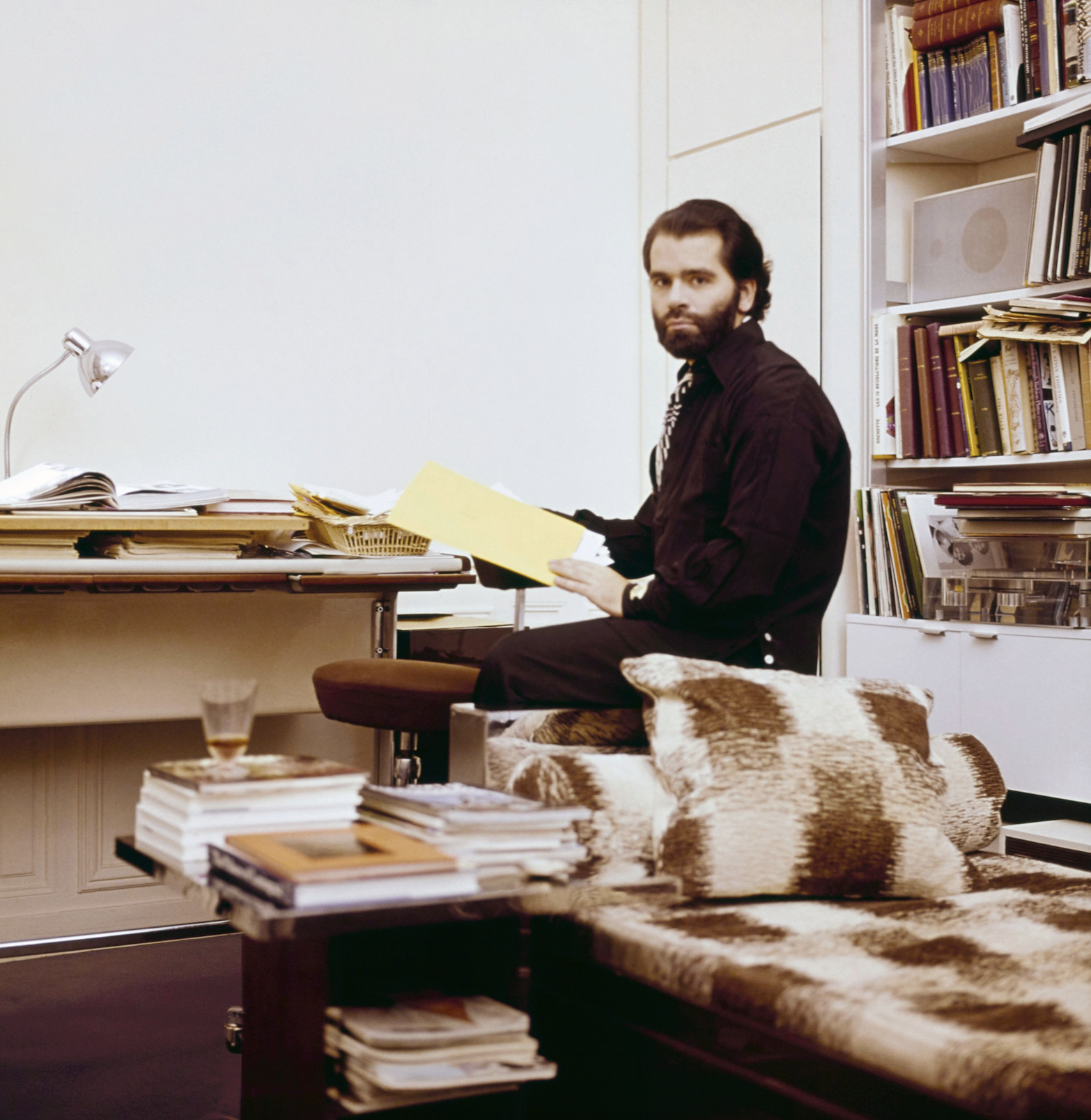
Lagerfeld’s increasing fame and financial success allowed him to indulge in an unprecedented spending frenzy, competing with deep-pocketed institutions like the Louvre to acquire the finest, most pedigreed pearls of the era—voluptuously carved and gilded bergères; ormolu chests; and fleshy, pastel-tinged Fragonard idylls—to adorn his urban palace. His one-time friend André Leon Talley described him in a contemporary article as suffering from “Versailles complex”.
However, in mid-1981, and in response to the election of left-wing president, François Mitterrand, Lagerfeld, with the assistance of his close friend Princess Caroline, became a resident of the tax haven of Monaco. He purchased two apartments on the 21st floor of Le Roccabella, a luxury residential block designed by Gio Ponti. One, in which he kept Jacques de Bascher, with whom he was now reconciled, was decorated in the strict, monochromatic Viennese Secessionist style that had long underpinned his aesthetic vocabulary; the other space, though, was something else entirely, cementing his notoriety as an iconoclastic tastemaker.
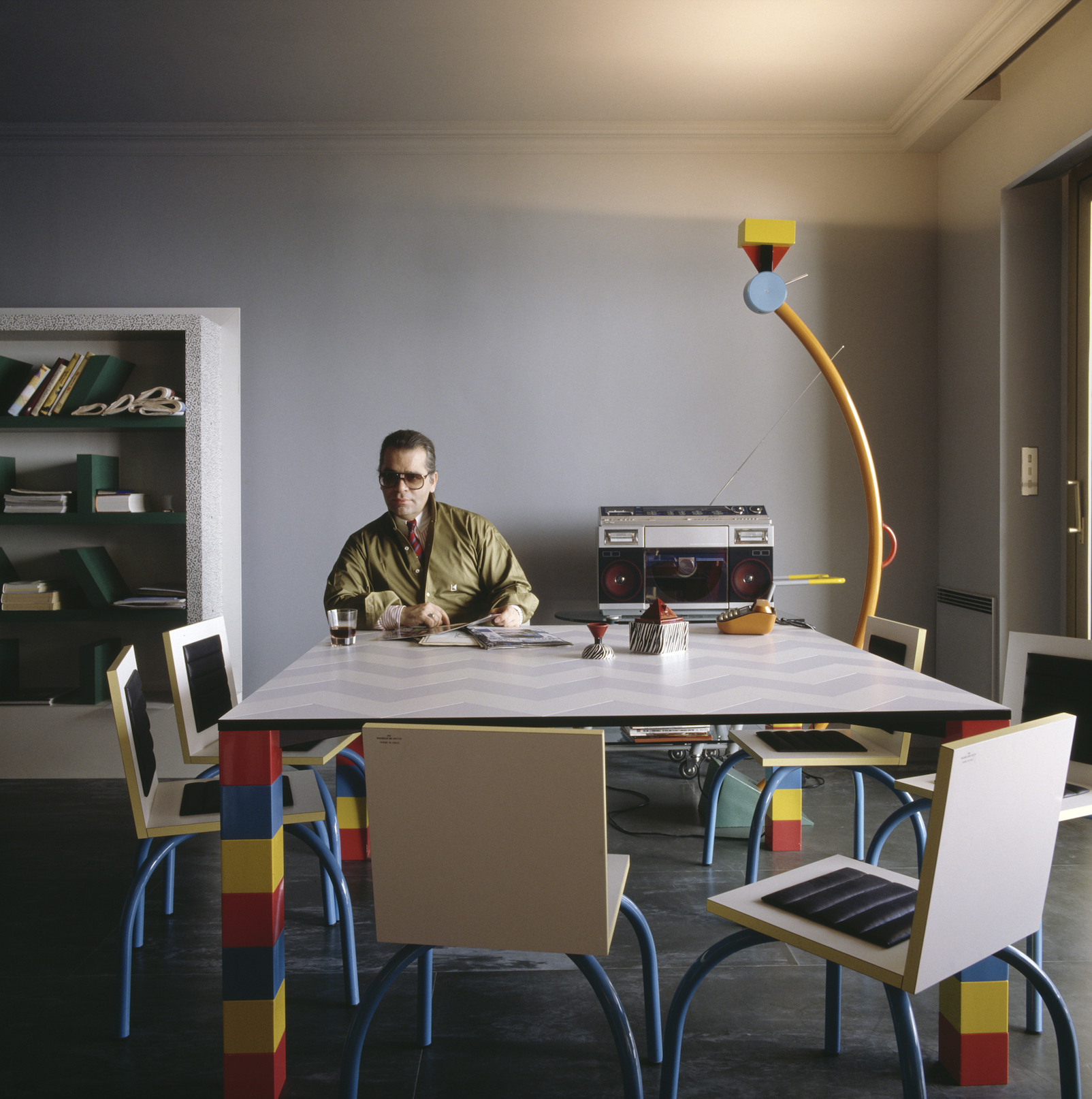
Lagerfeld had recently discovered the radically quirky designs of the Memphis Group led by Ettore Sottsass, and bought the collective’s entire first collection and had it shipped to Monaco. In a space with no right angles, these chaotically colourful, geometrically askew pieces—centred on Masanori Umeda’s famous boxing ring—gave visitors the disorientating sensation of having entered a corporeal comic strip. By 1991, the novelty of this jarring postmodern playhouse had inevitably worn thin and once again he sent it all to auction, later telling a journalist that “after a few years it was like living in an old Courrèges. Ha!”

In 1989, de Bascher died of an AIDS-related illness, and while Lagerfeld’s career continued to flourish, emotionally the famously stoic designer was struggling. In 2000, a somewhat corpulent Lagerfeld officially ended his “let them eat cake” years at the Hôtel Pozzo di Borgo, selling its sumptuous antique fittings in a massive headline auction that stretched over three days. As always there were other houses, but now with his longtime companion dead, and his celebrity metastasising making him a target for the paparazzi, he began to look less for exhibition spaces and more for private sanctuaries where he could pursue his endless, often lonely, work.
His next significant house was Villa Jako, named for his lost companion and built in the 1920s in a nouveau riche area of Hamburg close to where he grew up. Lagerfeld shot the advertising campaign for Lagerfeld Jako there—a fragrance created in memorial to de Bascher. The house featured a collection of mainly Scandinavian antiques, marking the aesthetic cusp between Art Nouveau and Art Deco. One of its rooms Lagerfeld decorated based on his remembrances of his childhood nursery. Here, he locked himself away to work—tellingly—on a series of illustrations for the fairy tale, The Emperor’s New Clothes. Villa Jako was a house of deep nostalgia and mourning.
But there were more acts—and more houses—to come in Lagerfeld’s life yet. In November 2000, upon seeing the attenuated tailoring of Hedi Slimane, then head of menswear at Christian Dior, the 135 kg Lagerfeld embarked on a strict dietary regime. Over the next 13 months, he melted into a shadow of his former self. It is this incarnation of Lagerfeld—high white starched collars; Slimane’s skintight suits, and fingerless leather gloves revealing hands bedecked with heavy silver rings—that is immediately recognisable some five years after his death.
The 200-year-old apartment in Quái Voltaire, Paris, was purchased in 2006, and after years of slumber Lagerfeld—a newly awakened Hip Van Winkle—was ready to remake it into his last modernist masterpiece. He designed a unique daylight simulation system that meant the monochromatic space was completely without shadows—and without memory. The walls were frosted and smoked glass, the floors concrete and silicone; and any hint of texture was banned with only shiny, sleek pieces by Marc Newson, Martin Szekely and the Bouroullec Brothers permitted. Few guests were allowed into this monastic environment where Lagerfeld worked, drank endless cans of Diet Coke and communed with Choupette, his beloved Birman cat, and parts of his collection of 300,000 books—one of the largest private collections in the world.
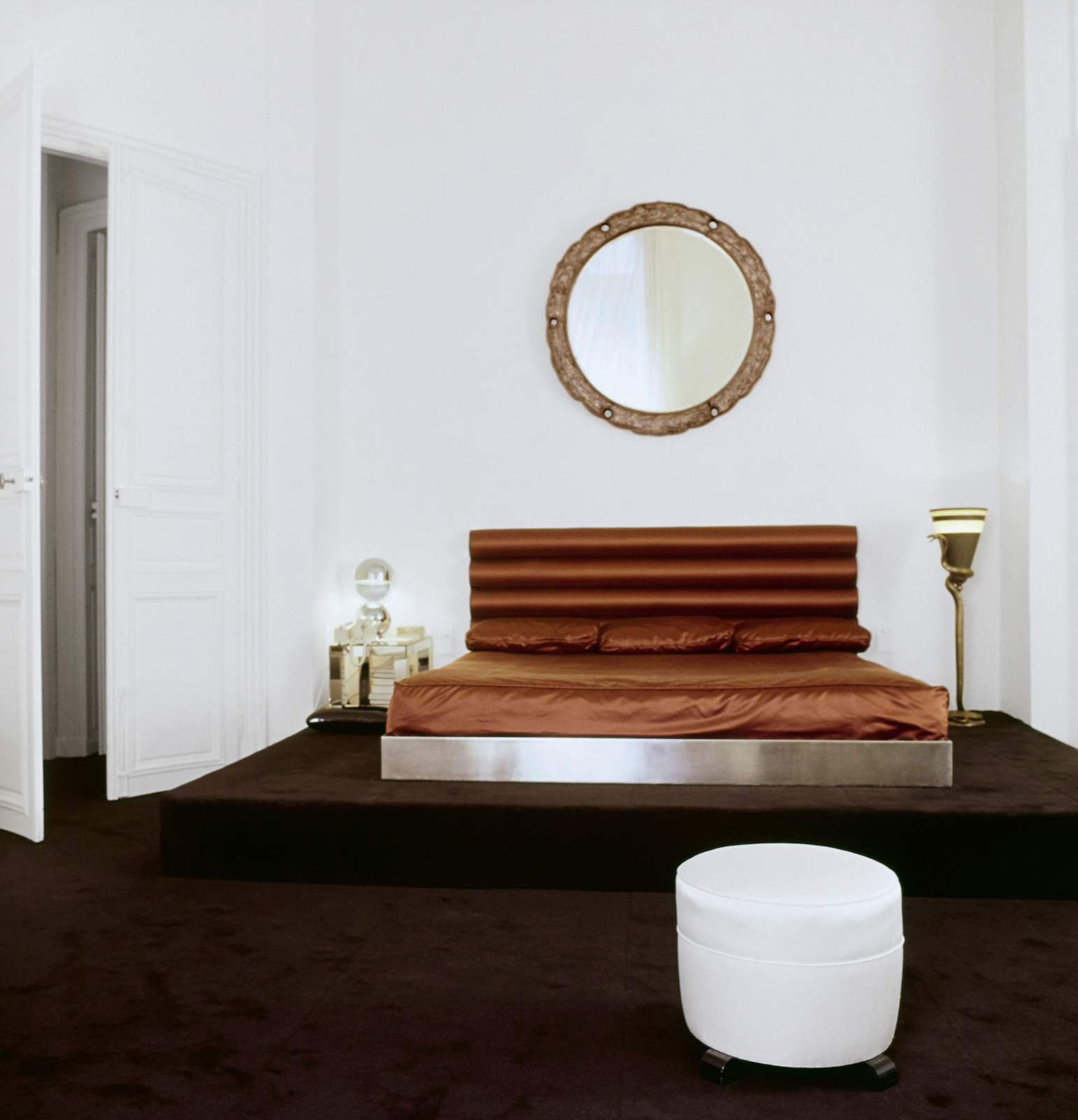
Lagerfeld died in 2019, and the process of dispersing his worldly goods is still ongoing. The Quái Voltaire apartment was sold this year for US$10.8 million (around $16.3 million). Now only the rue de Saint-Peres property remains within the Lagerfeld trust. Purchased after Quái Voltaire to further accommodate more of his books—35,000 were displayed in his studio alone, always stacked horizontally so he could read the titles without straining his neck—and as a place for food preparation as he loathed his primary living space having any trace of cooking smells. Today, the rue de Saint-Peres residence is open to the public as an arts performance space and most fittingly, a library.
You may also like.
By Josh Bozin
24/07/2024
Watch This Space: Mike Nouveau
Meet the game-changing horological influencers blazing a trail across social media—and doing things their own way.
In the thriving world of luxury watches, few people own a space that offers unfiltered digital amplification. And that’s precisely what makes the likes of Brynn Wallner, Teddy Baldassarre, Mike Nouveau and Justin Hast so compelling.
These thought-provoking digital crusaders are now paving the way for the story of watches to be told, and shown, in a new light. Speaking to thousands of followers on the daily—mainly via TikTok, Instagram and YouTube—these progressive commentators represent the new guard of watch pundits. And they’re swaying the opinions, and dollars, of the up-and-coming generations who now represent the target consumer of this booming sector.
—
MIKE NOUVEAU
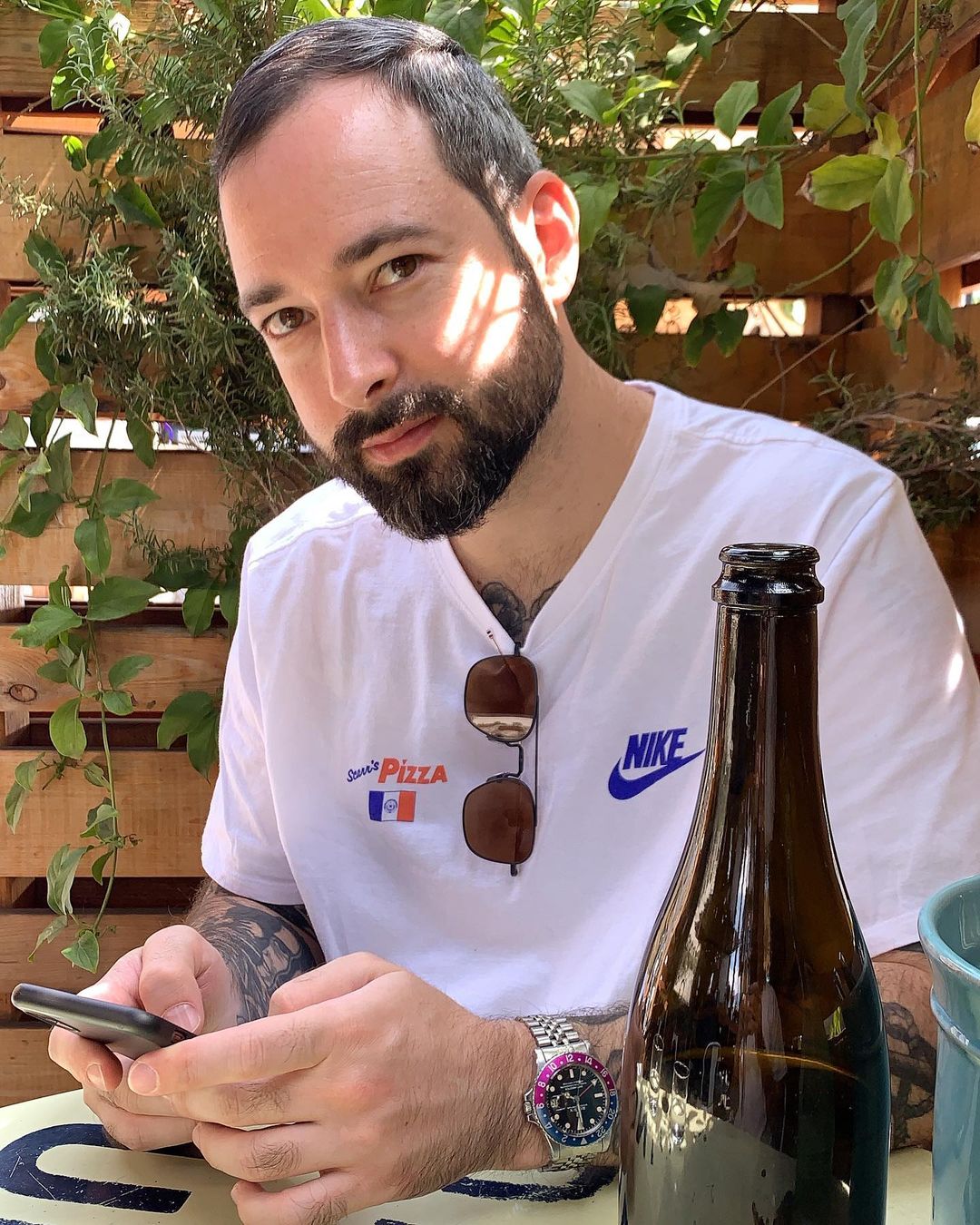
Can we please see what’s on the wrist? That’s the question that catapulted Mike Nouveau into watch stardom, thanks to his penchant for highlighting incredibly rare timepieces across his TikTok account of more than 400,000 followers. When viewing Nouveau’s attention-grabbing video clips—usually shot in a New York City neighbourhood—it’s not uncommon to find him wrist-rolling some of the world’s rarest timepieces, like the million-dollar Cartier Cheich (a clip he posted in May).
But how did someone without any previous watch experience come to amass such a cult following, and in the process gain access to some of the world’s most coveted timepieces? Nouveau admits had been a collector for many years, but moved didn’t move into horology full-time until 2020, when he swapped his DJing career for one as a vintage watch specialist.
“I probably researched for a year before I even bought my first watch,” says Nouveau, alluding to his Rolex GMT Master “Pepsi” ref. 1675 from 1967, a lionised timepiece in the vintage cosmos. “I would see deals arise that I knew were very good, but they weren’t necessarily watches that I wanted to buy myself. I eventually started buying and selling, flipping just for fun because I knew how to spot a good deal.”
Nouveau claims that before launching his TikTok account in the wake of Covid-19, no one in the watch community knew he existed. “There really wasn’t much watch content, if any, on TikTok before I started posting, especially talking about vintage watches. There’s still not that many voices for vintage watches, period,” says Nouveau. “It just so happens that my audience probably skews younger, and I’d say there are just as many young people interested in vintage watches as there are in modern watches.”
View this post on Instagram
Nouveau recently posted a video to his TikTok account revealing that the average price of a watch purchased by Gen Z is now almost US$11,000 (around $16,500), with 41 percent of them coming into possession of a luxury watch in the past 12 months.
“Do as much independent research as you can [when buying],” he advises. “The more you do, the more informed you are and the less likely you are to make a mistake. And don’t bring modern watch expectations to the vintage world because it’s very different. People say, ‘buy the dealer’, but I don’t do that. I trust myself and myself only.”
—
Read more about the influencers shaking up horology here with Justin Hast, Brynn Wallner and Teddy Baldassare.
You may also like.
By Josh Bozin
24/07/2024
This Pristine 1960 Ferrari 250 Spider Could Fetch $24 Million at Auction
The car wears the same colours and has the same engine it left the factory with.
Some Ferraris are just a little bit more important than others.
Take, for example, the 1960 250 GT SWB California that RM Sotheby’s is auctioning off during this year’s Monterey Car Week. Any example of the open-top beauty would attract interest, but this one just so happens to be the first one that was built.
The 250 is one of the most legendary series of cars in Ferrari history. Between 1952 and 1964, the company released 21 different 250 models—seven for racetracks, 14 for public roads—of which the “Cali Spider” might be the most well regarded, thanks to its potent V-12 and a Pininfarina-penned design that is one of the most beautiful bodies to grace an automobile. The roadster, which was specifically built for the U.S., made its debut in 1957 as a long-wheel-base model (LWB), but it wasn’t until the SWB model debut in 1960 that it became clear how special it was. This example isn’t just the first to roll off the line. It’s the actual car that was used to introduce the world to the model at the 1960 Geneva Motor Show.
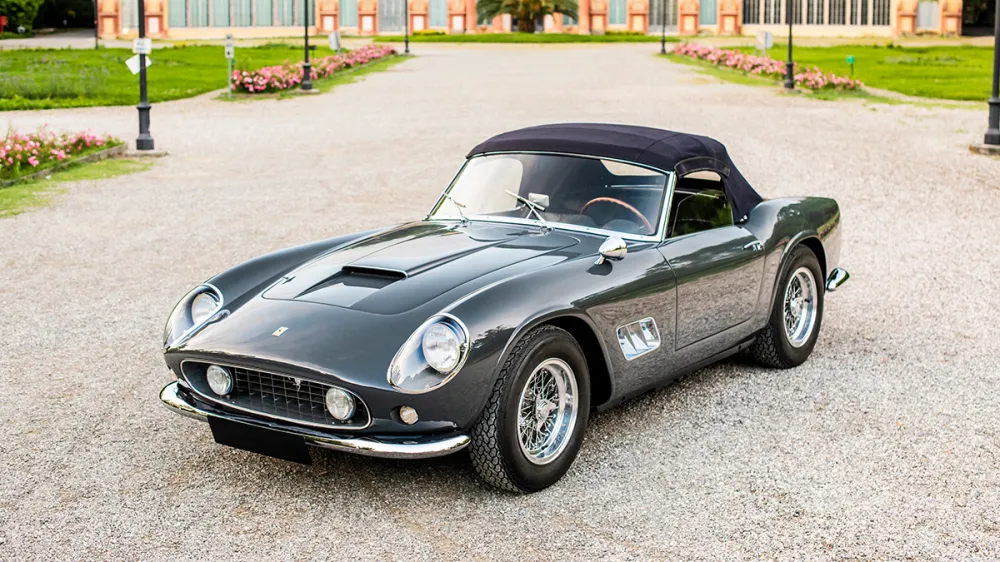
Just 56 examples of the 250 GT SWB California Spider would be built by Scaglietti during the three years it was in production. The first of those, chassis 1795 GT, is finished in a glossy coat of Grigio. The two-door had a red leather interior at Geneva but was returned to the factory and re-outfitted with black leather upholstery before being delivered to its original owner, British race car driver John Gordon Bennet. Six-and-a-half decades later the car looks identical to how it did when it left the factory the second time.
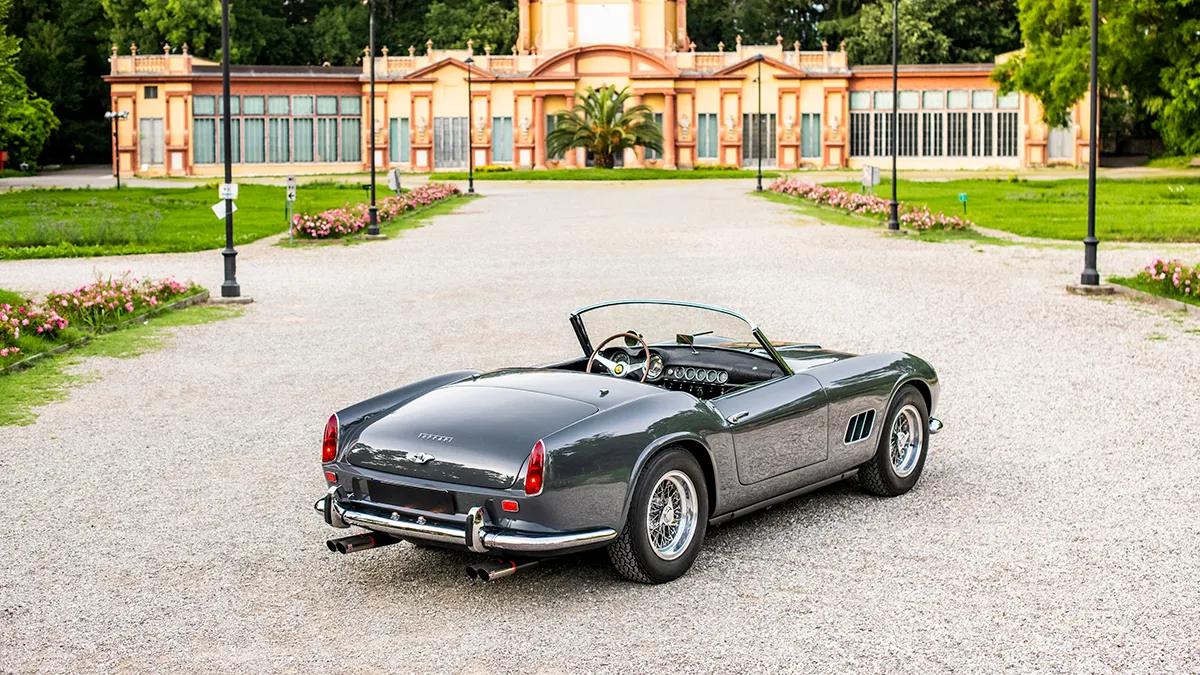
In addition to its original bodywork, the chassis 1795 GT features its original engine, gearbox, and rear axle. That mill is the competition-spec Tipo 168, a 3.0-litre V-12 that makes 196.1 kW. That may not sound like much by today’s standards, but, when you consider that the 250 GT SWB California Spider tips the scales around 952 kilograms, it’s more than enough.
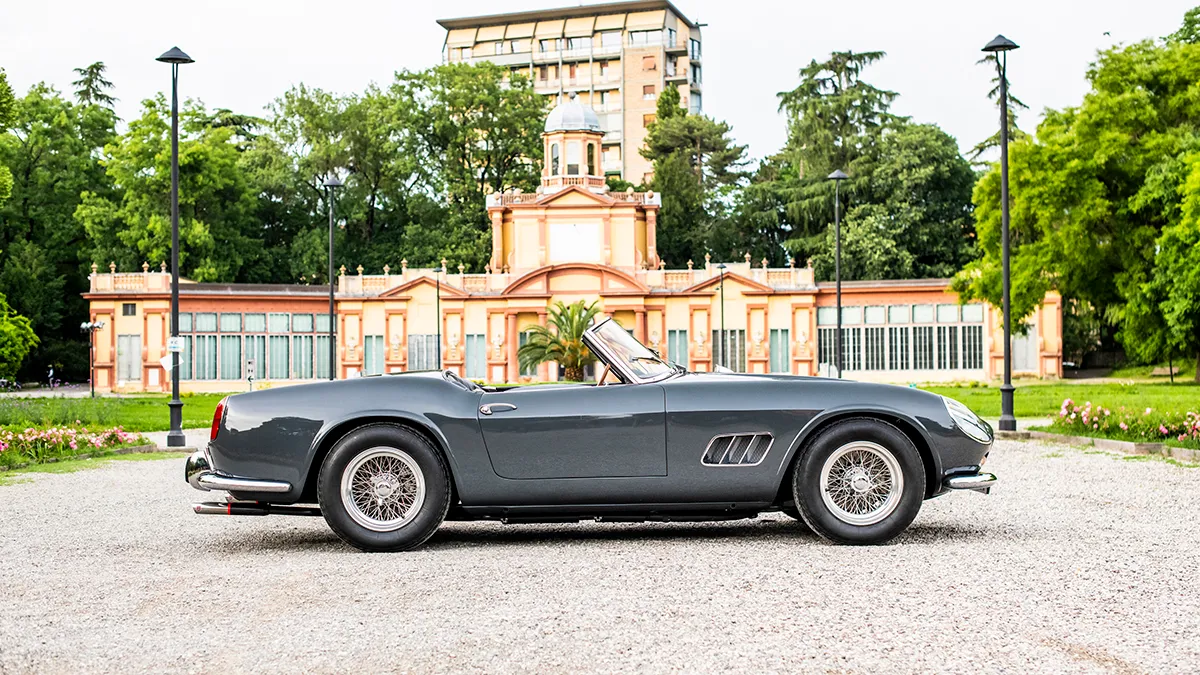
The first 250 GT SWB California Spider is scheduled to go up for bid during RM Sotheby’s annual Monterey Car Week auction, which runs from Thursday, August 15, to Saturday, August 17. Unsurprisingly, the house has quite high hopes for the car. The car carries an estimate of between $24 million and $26 million, which could make it one of the most expensive cars ever sold at auction.
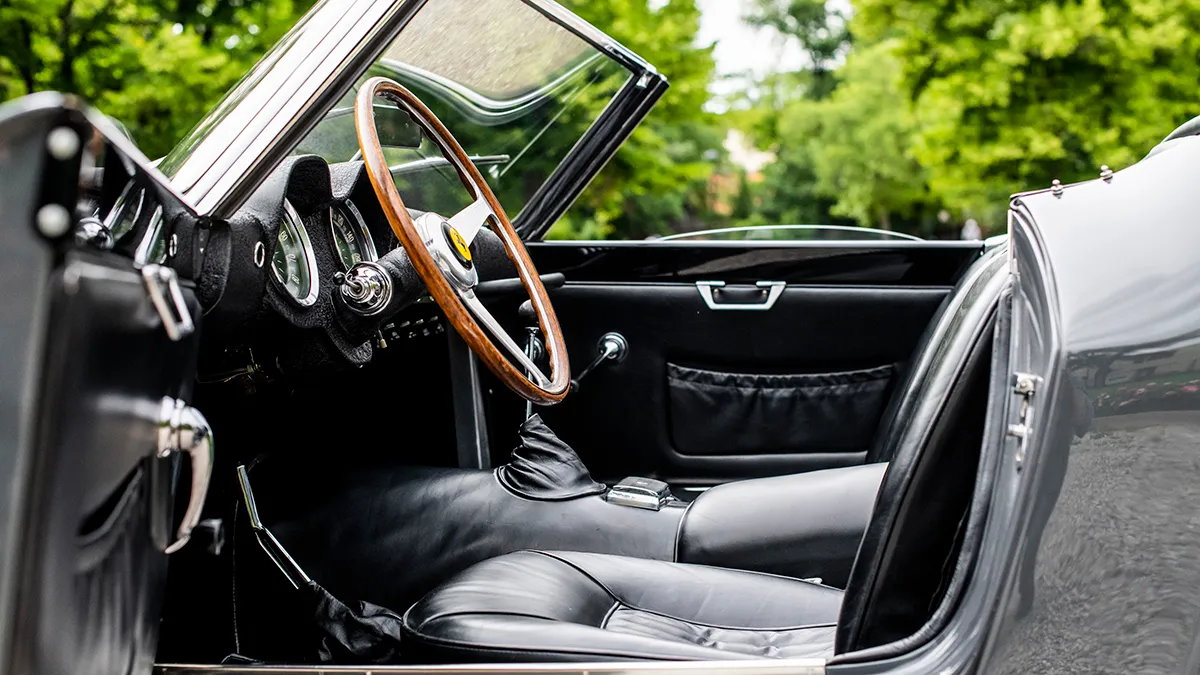
You may also like.
By Josh Bozin
24/07/2024






